Assessing the Impact of Urban Morphologies on Waterlogging Risk Using a Spatial Weight Naive Bayes Model and Local Climate Zones Classification
Abstract
1. Introduction
2. Study Area and Data Sources
2.1. Study Area
2.2. Data Sources
2.3. Spatial Distribution of Urban Morphology Factors
3. Methodology
3.1. Spatially Weighted Naive Bayes Model
3.2. Local Climate Zones Classification
3.3. Environmental Equity Calculation
3.4. Waterlogging Risk Classification
4. Results and Discussion
4.1. LCZs Classification Results
4.2. Spatial Distribution of Waterlogging Point and Risk Levels
4.3. Urban Waterlogging Risk in Different LCZs
4.4. Waterlogging Exposure Distribution in Different Streets
4.5. Theil Index of Different Streets
4.6. Discussion
5. Conclusions
Author Contributions
Funding
Data Availability Statement
Conflicts of Interest
Nomenclature
| LCZ | Local climate zones |
| DEM | Digital Elevation Model |
| DW | Distance to the waterway |
| FVC | Fractional vegetation cover |
| ISF | Impervious surface fraction |
| PWE | Population-weighted exposure |
| RD | Road density |
| SWR | Soil water retention |
| WNB | Weighted naive Bayes |
| WUDAPT | World Urban Database and Access Portal Tools |
References
- Liang, L.; Song, Y.; Shao, Z.; Zheng, C.; Liu, X.; Li, Y. Exploring the Causal Relationships and Pathways between Ecological Environmental Quality and Influencing Factors: A Comprehensive Analysis. Ecol. Indic. 2024, 165, 112192. [Google Scholar] [CrossRef]
- Guo, Y.; Zhao, S.; Zhao, X.; Wang, H.; Shi, W. Evaluation of the Spatiotemporal Change of Ecological Quality under the Context of Urban Expansion—A Case Study of Typical Urban Agglomerations in China. Remote Sens. 2024, 16, 45. [Google Scholar] [CrossRef]
- Mehmood, U. Assessing the Impacts of Eco-Innovations, Economic Growth, Urbanization on Ecological Footprints in G-11: Exploring the Sustainable Development Policy Options. J. Knowl. Econ. 2024. [Google Scholar] [CrossRef]
- World Population Prospects 2022: Methodoology of the United Nations Population Estimates and Projections. 2022. Available online: https://population.un.org/wpp/ (accessed on 20 July 2024).
- Tang, Z.; Wang, P.; Li, Y.; Sheng, Y.; Wang, B.; Popovych, N.; Hu, T. Contributions of Climate Change and Urbanization to Urban Flood Hazard Changes in China’s 293 Major Cities since 1980. J. Environ. Manag. 2024, 353, 120113. [Google Scholar] [CrossRef]
- Ombadi, M.; Risser, M.D.; Rhoades, A.M.; Varadharajan, C. A Warming-Induced Reduction in Snow Fraction Amplifies Rainfall Extremes. Nature 2023, 619, 305–310. [Google Scholar] [CrossRef]
- Myhre, G.; Alterskjær, K.; Stjern, C.W.; Hodnebrog, Ø.; Marelle, L.; Samset, B.H.; Sillmann, J.; Schaller, N.; Fischer, E.; Schulz, M.; et al. Frequency of Extreme Precipitation Increases Extensively with Event Rareness under Global Warming. Sci. Rep. 2019, 9, 16063. [Google Scholar] [CrossRef]
- Intergovernmental Panel on Climate Change (IPCC). Climate Change 2021—The Physical Science Basis: Working Group I Contribution to the Sixth Assessment Report of the Intergovernmental Panel on Climate Change; Cambridge University Press: Cambridge, UK, 2023. [Google Scholar]
- Zhang, D.L.; Lin, Y.; Zhao, P.; Yu, X.; Wang, S.; Kang, H.; Ding, Y. The Beijing Extreme Rainfall of 21 July 2012: “Right Results” but for Wrong Reasons. Geophys. Res. Lett. 2013, 40, 1426–1431. [Google Scholar] [CrossRef]
- Qi, Y.; Chan, F.K.; Thorne, C.; O’Donnell, E.; Quagliolo, C.; Comino, E.; Pezzoli, A.; Li, L.; Griffiths, J.; Sang, Y.; et al. Addressing Challenges of Urban Water Management in Chinese Sponge Cities via Nature-Based Solutions. Water 2020, 12, 2788. [Google Scholar] [CrossRef]
- Wang, M.; Li, Y.; Yuan, H.; Zhou, S.; Wang, Y.; Adnan Ikram, R.M.; Li, J. An XGBoost-SHAP Approach to Quantifying Morphological Impact on Urban Flooding Susceptibility. Ecol. Indic. 2023, 156, 111137. [Google Scholar] [CrossRef]
- Li, Z.; Wang, Z.; Wu, L.; Huang, W.; Peng, W. Evaluating the Effect of Building Patterns on Urban Flooding Based on a Boosted Regression Tree: A Case Study of Beijing, China. Hydrol. Process. 2023, 37, e14932. [Google Scholar] [CrossRef]
- Qian, Y.; Chakraborty, T.C.; Li, J.; Li, D.; He, C.; Sarangi, C.; Chen, F.; Yang, X.; Leung, L.R. Urbanization Impact on Regional Climate and Extreme Weather: Current Understanding, Uncertainties, and Future Research Directions. Adv. Atmos. Sci. 2022, 39, 819–860. [Google Scholar] [CrossRef] [PubMed]
- Liu, J.; Niyogi, D. Meta-Analysis of Urbanization Impact on Rainfall Modification. Sci. Rep. 2019, 9, 7301. [Google Scholar] [CrossRef] [PubMed]
- Zhang, W.; Villarini, G.; Vecchi, G.A.; Smith, J.A. Urbanization Exacerbated the Rainfall and Flooding Caused by Hurricane Harvey in Houston. Nature 2018, 563, 384–388. [Google Scholar] [CrossRef]
- Gu, Y.; Li, D. A Modeling Study of the Sensitivity of Urban Heat Islands to Precipitation at Climate Scales. Urban Clim. 2018, 24, 982–993. [Google Scholar] [CrossRef]
- Fu, Y.; Jiang, S.; Mao, Y.; Wu, G. Urbanization Reshapes Extreme Precipitation Metrics in Typical Urban Agglomerations of Eastern China. Atmos. Res. 2024, 300, 107253. [Google Scholar] [CrossRef]
- Li, C.; Sun, N.; Lu, Y.; Guo, B.; Wang, Y.; Sun, X.; Yao, Y. Review on Urban Flood Risk Assessment. Sustainability 2023, 15, 765. [Google Scholar] [CrossRef]
- Wang, Y.; Xie, X.; Liang, S.; Zhu, B.; Yao, Y.; Meng, S.; Lu, C. Quantifying the Response of Potential Flooding Risk to Urban Growth in Beijing. Sci. Total Environ. 2020, 705, 135868. [Google Scholar] [CrossRef]
- Mei, C.; Shi, H.; Liu, J.; Song, T.; Wang, J.; Gao, X.; Wang, H.; Li, M. Analyzing Urban Form Influence on Pluvial Flooding via Numerical Experiments Using Random Slices of Actual City Data. J. Hydrol. 2024, 633, 130916. [Google Scholar] [CrossRef]
- Bruwier, M.; Mustafa, A.; Aliaga, D.G.; Archambeau, P.; Erpicum, S.; Nishida, G.; Zhang, X.; Pirotton, M.; Teller, J.; Dewals, B. Influence of Urban Pattern on Inundation Flow in Floodplains of Lowland Rivers. Sci. Total Environ. 2018, 622–623, 446–458. [Google Scholar] [CrossRef]
- Lin, J.; He, P.; Yang, L.; He, X.; Lu, S.; Liu, D. Predicting Future Urban Waterlogging-Prone Areas by Coupling the Maximum Entropy and FLUS Model. Sustain. Cities Soc. 2022, 80, 103812. [Google Scholar] [CrossRef]
- Stewart, I.D.; Oke, T.R. Local Climate Zones for Urban Temperature Studies. Bull. Am. Meteorol. Soc. 2012, 93, 1879–1900. [Google Scholar] [CrossRef]
- Zhang, L.; Nikolopoulou, M.; Guo, S.; Song, D. Impact of LCZs Spatial Pattern on Urban Heat Island: A Case Study in Wuhan, China. Build. Environ. 2022, 226, 109785. [Google Scholar] [CrossRef]
- Fan, C.; Zou, B.; Li, J.; Wang, M.; Liao, Y.; Zhou, X. Exploring the Relationship between Air Temperature and Urban Morphology Factors Using Machine Learning under Local Climate Zones. Case Stud. Therm. Eng. 2024, 55, 104151. [Google Scholar] [CrossRef]
- Zou, B.; Fan, C.; Li, J. Quantifying the Influence of Different Block Types on the Urban Heat Risk in High-Density Cities. Buildings 2024, 14, 2131. [Google Scholar] [CrossRef]
- Bechtel, B.; Demuzere, M.; Mills, G.; Zhan, W.; Sismanidis, P.; Small, C.; Voogt, J. SUHI Analysis Using Local Climate Zones—A Comparison of 50 Cities. Urban Clim. 2019, 28, 100451. [Google Scholar] [CrossRef]
- Zhou, L.; Yuan, B.; Hu, F.; Wei, C.; Dang, X.; Sun, D. Understanding the Effects of 2D/3D Urban Morphology on Land Surface Temperature Based on Local Climate Zones. Build. Environ. 2022, 208, 108578. [Google Scholar] [CrossRef]
- Yang, J.; Ren, J.; Sun, D.; Xiao, X.; Xia, J.; Jin, C.; Li, X. Understanding Land Surface Temperature Impact Factors Based on Local Climate Zones. Sustain. Cities Soc. 2021, 69, 102818. [Google Scholar] [CrossRef]
- Ching, J.; Mills, G.; Bechtel, B.; See, L.; Feddema, J.; Wang, X.; Ren, C.; Brousse, O.; Martilli, A.; Neophytou, M.; et al. WUDAPT: An Urban Weather, Climate, and Environmental Modeling Infrastructure for the Anthropocene. Bull. Am. Meteorol. Soc. 2018, 99, 1907–1924. [Google Scholar] [CrossRef]
- Palla, A.; Gnecco, I. Hydrologic Modeling of Low Impact Development Systems at the Urban Catchment Scale. J. Hydrol. 2015, 528, 361–368. [Google Scholar] [CrossRef]
- Mosavi, A.; Ozturk, P.; Chau, K. Flood Prediction Using Machine Learning Models: Literature Review. Water 2018, 10, 1536. [Google Scholar] [CrossRef]
- Rafiei-Sardooi, E.; Azareh, A.; Choubin, B.; Mosavi, A.H.; Clague, J.J. Evaluating Urban Flood Risk Using Hybrid Method of TOPSIS and Machine Learning. Int. J. Disaster Risk Reduct. 2021, 66, 102614. [Google Scholar] [CrossRef]
- Seydi, S.T.; Kanani-Sadat, Y.; Hasanlou, M.; Sahraei, R.; Chanussot, J.; Amani, M. Comparison of Machine Learning Algorithms for Flood Susceptibility Mapping. Remote Sens. 2023, 15, 192. [Google Scholar] [CrossRef]
- Adnan, M.N. Improving the Random Forest Algorithm by Randomly Varying the Size of the Bootstrap Samples. In Proceedings of the 2014 IEEE 15th International Conference on Information Reuse and Integration (IEEE IRI 2014), Redwood City, CA, USA, 13–15 August 2014; pp. 303–308. [Google Scholar]
- Li, H.-X.; Yang, J.-L.; Zhang, G.; Fan, B. Probabilistic Support Vector Machines for Classification of Noise Affected Data. Inf. Sci. 2013, 221, 60–71. [Google Scholar] [CrossRef]
- Tang, X.; Li, J.; Liu, M.; Liu, W.; Hong, H. Flood Susceptibility Assessment Based on a Novel Random Naïve Bayes Method: A Comparison between Different Factor Discretization Methods. CATENA 2020, 190, 104536. [Google Scholar] [CrossRef]
- Tang, X.; Shu, Y.; Lian, Y.; Zhao, Y.; Fu, Y. A Spatial Assessment of Urban Waterlogging Risk Based on a Weighted Naïve Bayes Classifier. Sci. Total Environ. 2018, 630, 264–274. [Google Scholar] [CrossRef]
- Liu, R.; Chen, Y.; Wu, J.; Gao, L.; Barrett, D.; Xu, T.; Li, X.; Li, L.; Huang, C.; Yu, J. Integrating Entropy-Based Naïve Bayes and GIS for Spatial Evaluation of Flood Hazard. Risk Anal. 2017, 37, 756–773. [Google Scholar] [CrossRef]
- Ebi, K.L.; Vanos, J.; Baldwin, J.W.; Bell, J.E.; Hondula, D.M.; Errett, N.A.; Hayes, K.; Reid, C.E.; Saha, S.; Spector, J. Extreme Weather and Climate Change: Population Health and Health System Implications. Annu. Rev. Public Health 2021, 42, 293–315. [Google Scholar] [CrossRef]
- Demuzere, M.; Orru, K.; Heidrich, O.; Olazabal, E.; Geneletti, D.; Orru, H.; Bhave, A.G.; Mittal, N.; Feliu, E.; Faehnle, M. Mitigating and Adapting to Climate Change: Multi-Functional and Multi-Scale Assessment of Green Urban Infrastructure. J. Environ. Manag. 2014, 146, 107–115. [Google Scholar] [CrossRef]
- Hsu, A.; Sheriff, G.; Chakraborty, T.; Manya, D. Disproportionate Exposure to Urban Heat Island Intensity across Major US Cities. Nat. Commun. 2021, 12, 2721. [Google Scholar] [CrossRef]
- Guangzhou Statistics Bureau. Available online: https://tjj.gz.gov.cn/ (accessed on 29 July 2024).
- Tehrany, M.S.; Pradhan, B.; Mansor, S.; Ahmad, N. Flood Susceptibility Assessment Using GIS-Based Support Vector Machine Model with Different Kernel Types. Catena 2015, 125, 91–101. [Google Scholar] [CrossRef]
- Zhang, X.; Liu, L.; Wu, C.; Chen, X.; Gao, Y.; Xie, S.; Zhang, B. Development of a Global 30 m Impervious Surface Map Using Multisource and Multitemporal Remote Sensing Datasets with the Google Earth Engine Platform. Earth Syst. Sci. Data 2020, 12, 1625–1648. [Google Scholar] [CrossRef]
- McCuen, R.H. A Guide to Hydrologic Analysis Using SCS Methods; Prentice-Hall, Inc.: Hoboken, NJ, USA, 1982. [Google Scholar]
- Johnston, J.H. Theil. Economics and Information Theory. Econ. J. 1969, 79, 601–602. [Google Scholar] [CrossRef]
- Zeng, J.; Huang, G. Set Pair Analysis for Karst Waterlogging Risk Assessment Based on AHP and Entropy Weight. Hydrol. Res. 2017, 49, 1143–1155. [Google Scholar] [CrossRef]
- Creutzig, F.; Lohrey, S.; Bai, X.; Baklanov, A.; Dawson, R.; Dhakal, S.; Lamb, W.F.; McPhearson, T.; Minx, J.; Munoz, E.; et al. Upscaling Urban Data Science for Global Climate Solutions. Glob. Sustain. 2019, 2, e2. [Google Scholar] [CrossRef]
- Bechtel, B.; Alexander, P.J.; Böhner, J.; Ching, J.; Conrad, O.; Feddema, J.; Mills, G.; See, L.; Stewart, I. Mapping Local Climate Zones for a Worldwide Database of the Form and Function of Cities. ISPRS Int. J. Geo-Inf. 2015, 4, 199–219. [Google Scholar] [CrossRef]
- Brousse, O.; Georganos, S.; Demuzere, M.; Dujardin, S.; Lennert, M.; Linard, C.; Snow, R.W.; Thiery, W.; van Lipzig, N.P.M. Can We Use Local Climate Zones for Predicting Malaria Prevalence across Sub-Saharan African Cities? Environ. Res. Lett. 2020, 15, 124051. [Google Scholar] [CrossRef]
- Li, S.; Wen, R.; Li, J.; Yang, H.; Chen, T.; Zhu, N. Impact of Land Use Landscape Pattern on Carbon Emission Performance in Five Major Urban Agglomerations in China. Econ. Geogr. 2023, 43, 91–102. [Google Scholar] [CrossRef]
- Liu, M.; Wang, Y.; Liu, R.; Ding, C.; Zhou, G.; Han, L. How Magnitude of PM2.5 Exposure Disparities Have Evolved across Chinese Urban-Rural Population during 2010–2019. J. Clean. Prod. 2023, 382, 135333. [Google Scholar] [CrossRef]
- Tang, X.; Shu, Y.; Liu, W.; Li, J.; Liu, M.; Yu, H. An Optimized Weighted Naïve Bayes Method for Flood Risk Assessment. Risk Anal. 2021, 41, 2301–2321. [Google Scholar] [CrossRef]
- Xu, X.; Qiu, W.; Li, W.; Huang, D.; Li, X.; Yang, S. Comparing Satellite Image and GIS Data Classified Local Climate Zones to Assess Urban Heat Island: A Case Study of Guangzhou. Front. Environ. Sci. 2022, 10, 1029445. [Google Scholar] [CrossRef]
- Huang, S.; Gan, Y.; Chen, N.; Wang, C.; Zhang, X.; Li, C.; Horton, D.E. Urbanization Enhances Channel and Surface Runoff: A Quantitative Analysis Using Both Physical and Empirical Models over the Yangtze River Basin. J. Hydrol. 2024, 635, 131194. [Google Scholar] [CrossRef]
- Du, S.; Shi, P.; Van Rompaey, A.; Wen, J. Quantifying the Impact of Impervious Surface Location on Flood Peak Discharge in Urban Areas. Nat. Hazard. 2015, 76, 1457–1471. [Google Scholar] [CrossRef]
- Xu, T.; Xie, Z.; Zhao, F.; Li, Y.; Yang, S.; Zhang, Y.; Yin, S.; Chen, S.; Li, X.; Zhao, S.; et al. Permeability Control and Flood Risk Assessment of Urban Underlying Surface: A Case Study of Runcheng South Area, Kunming. Nat. Hazard. 2022, 111, 661–686. [Google Scholar] [CrossRef]
- Feng, B.; Zhang, Y.; Bourke, R. Urbanization Impacts on Flood Risks Based on Urban Growth Data and Coupled Flood Models. Nat. Hazard. 2021, 106, 613–627. [Google Scholar] [CrossRef]
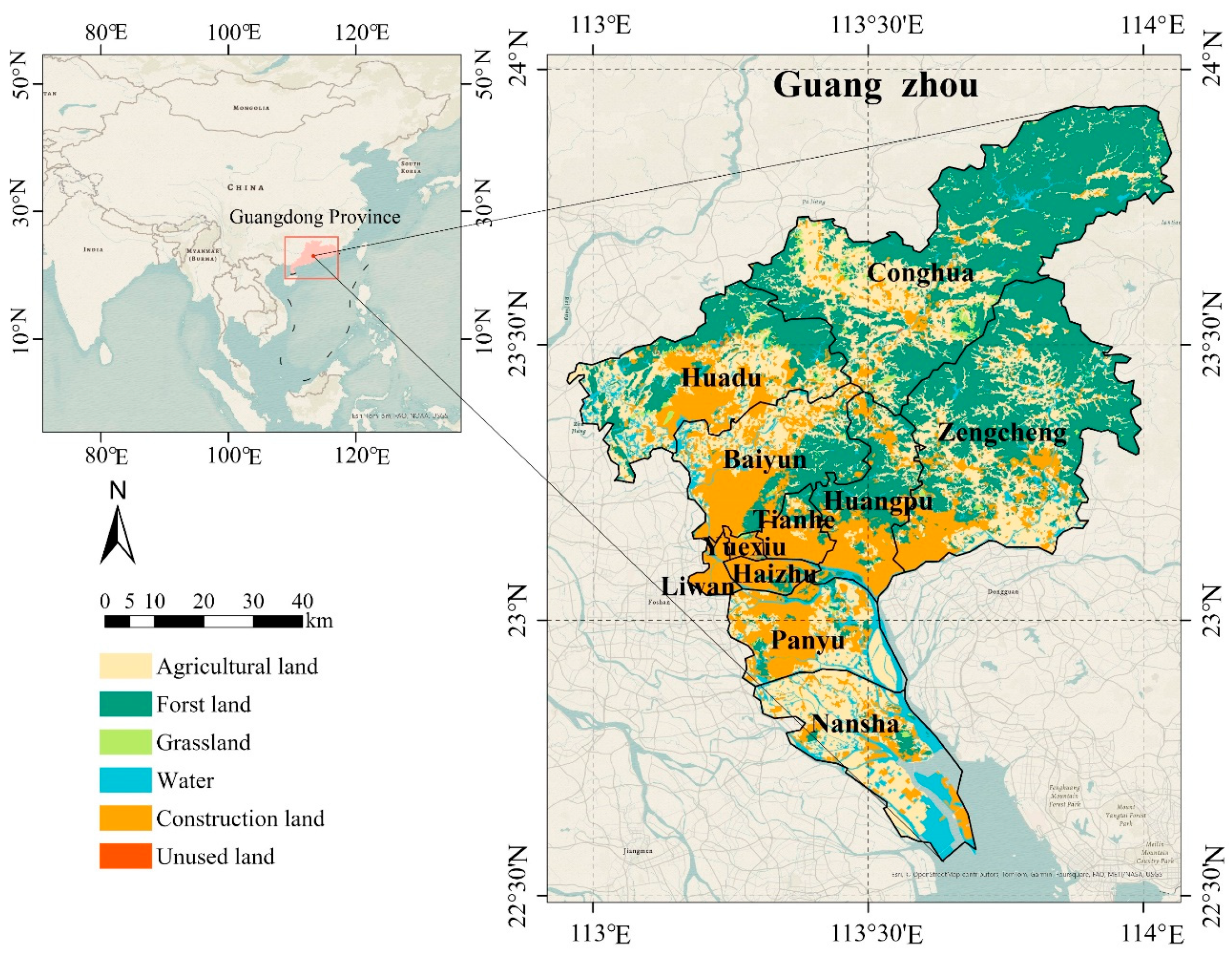

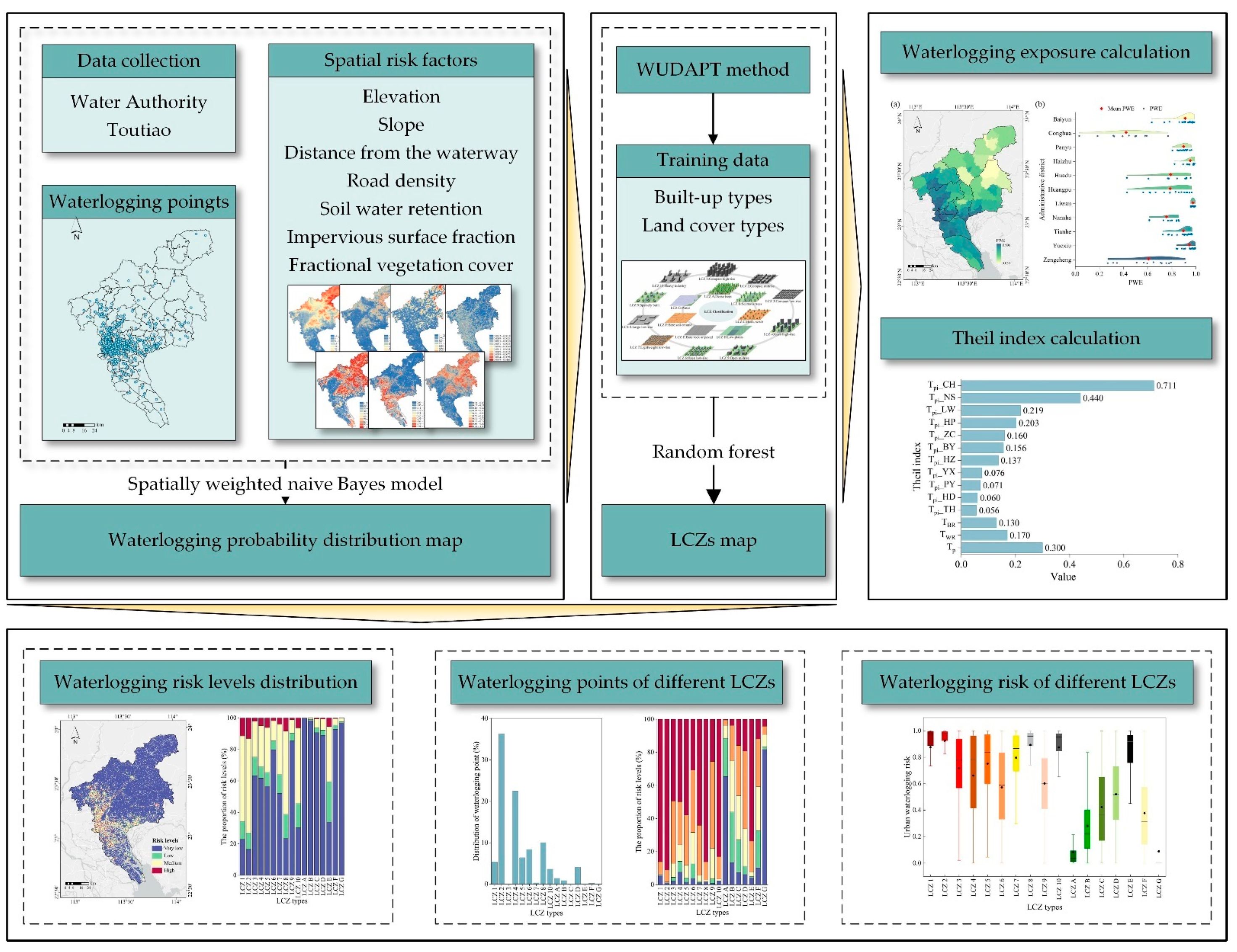
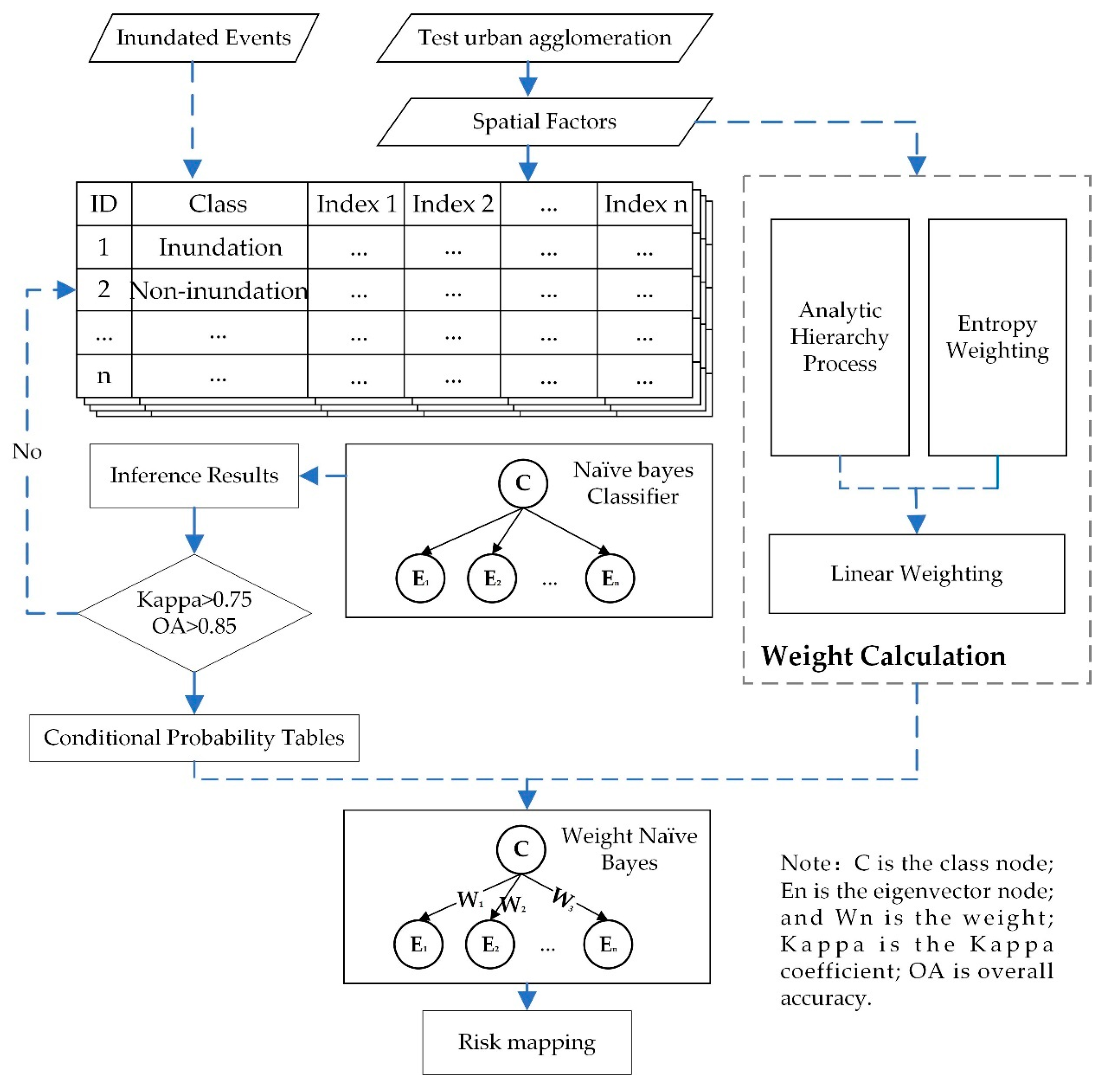

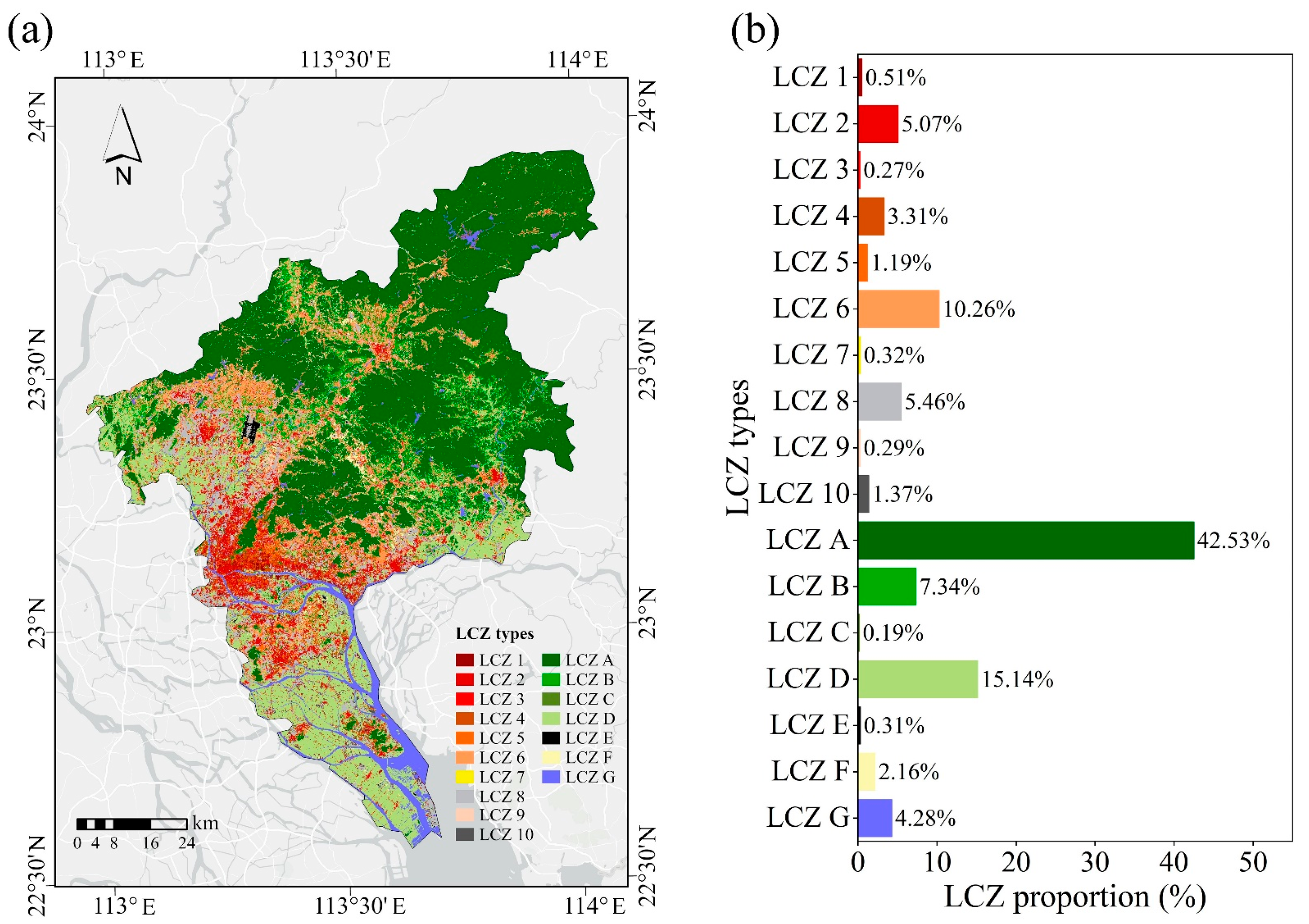
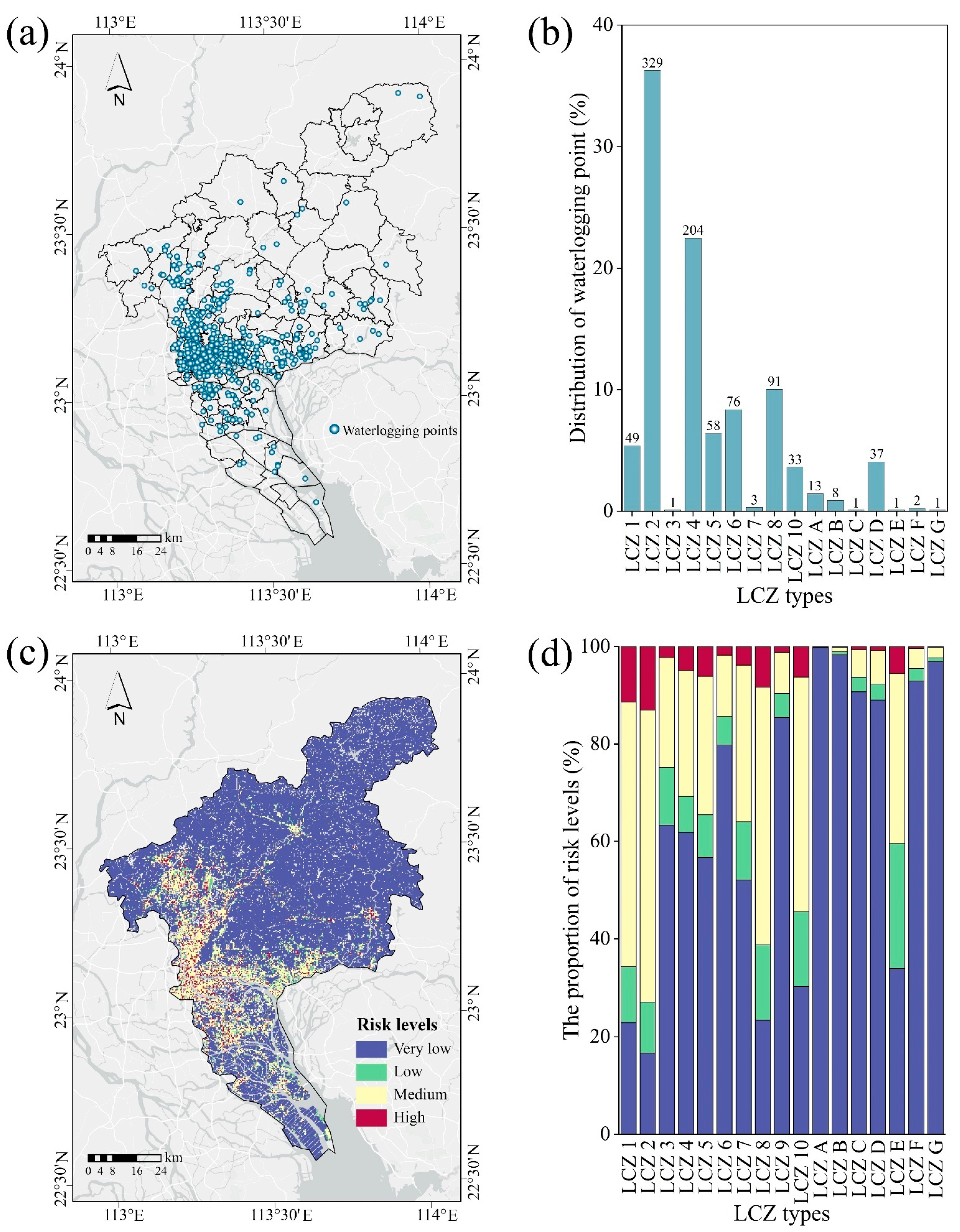
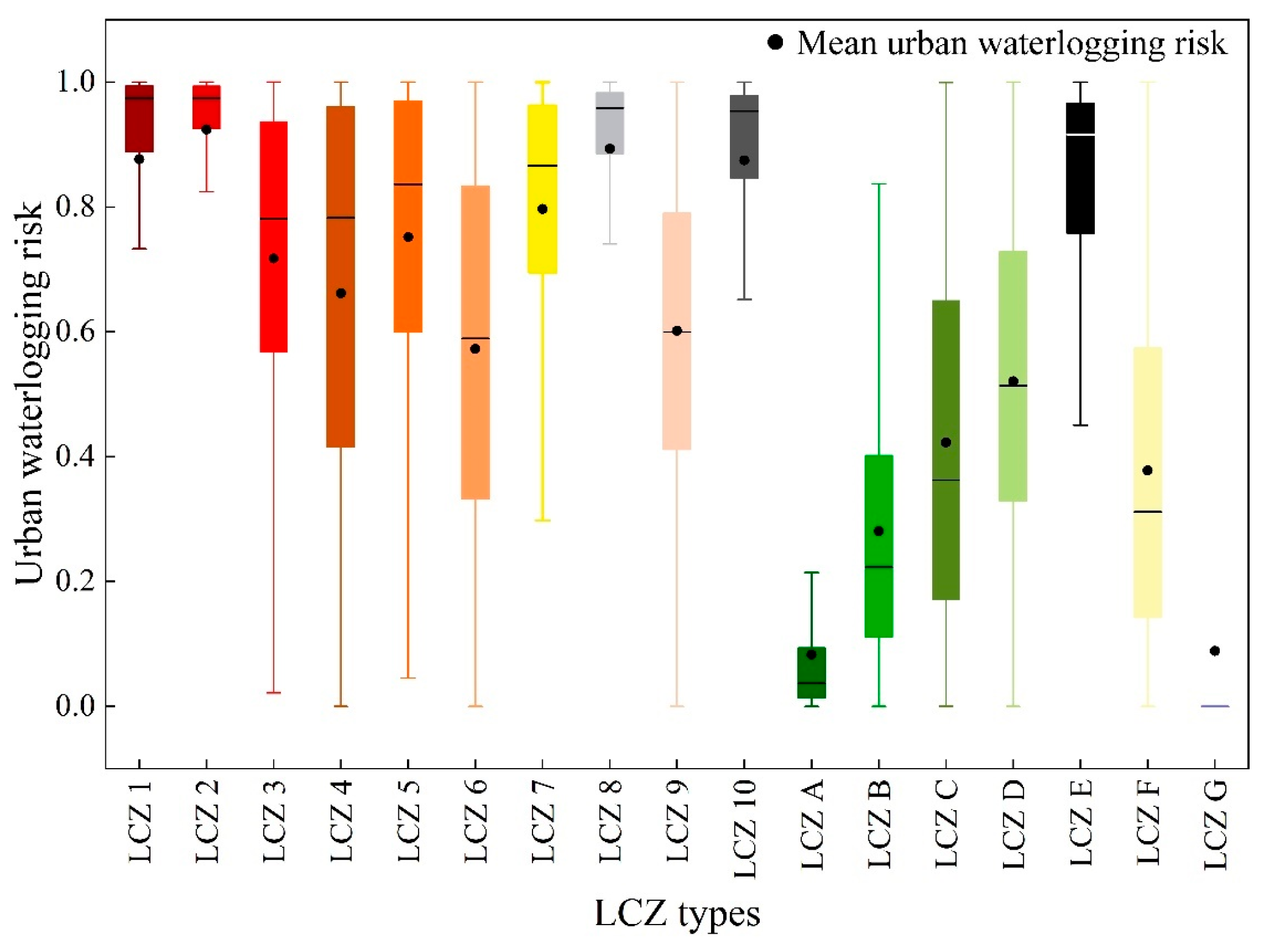
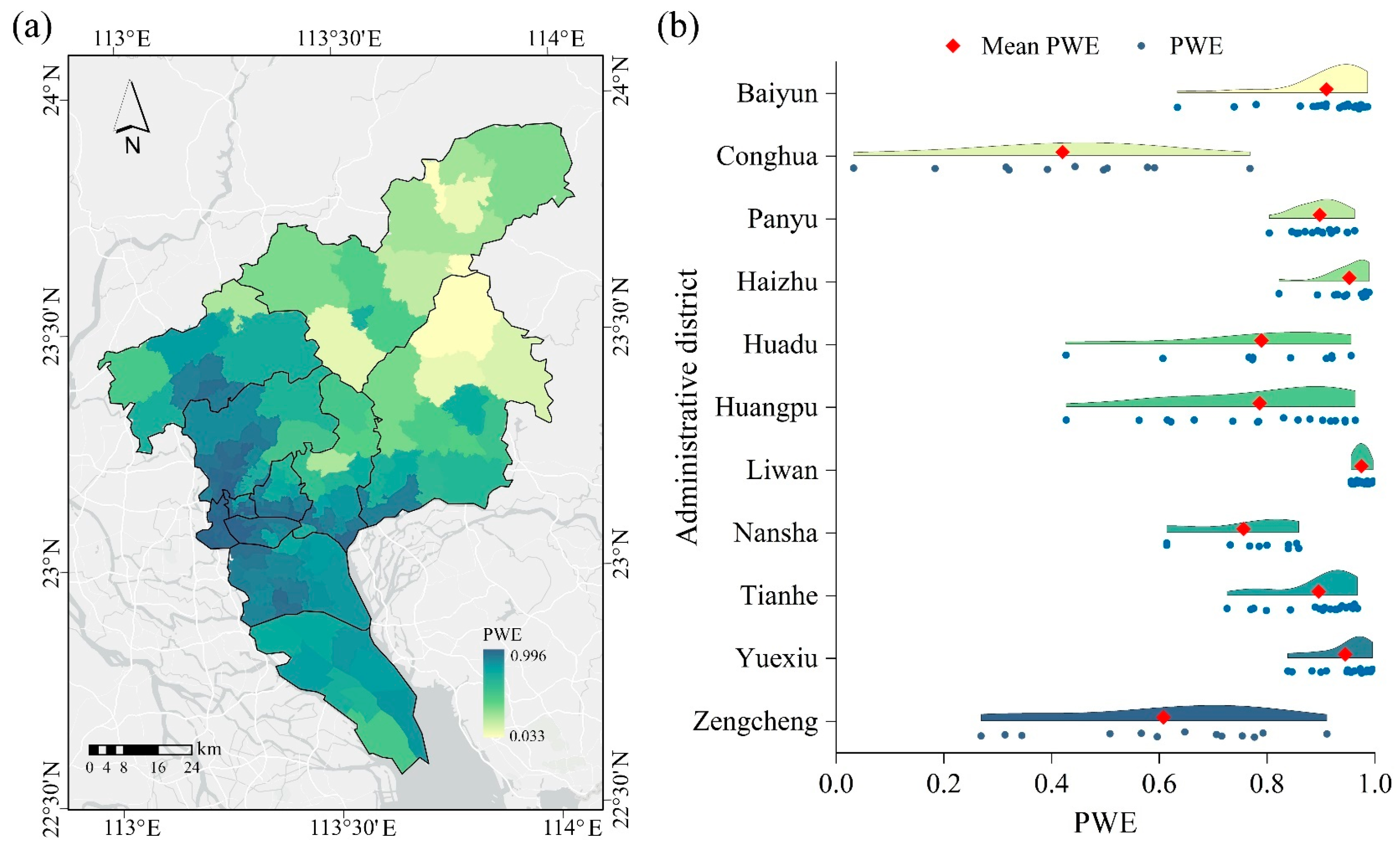
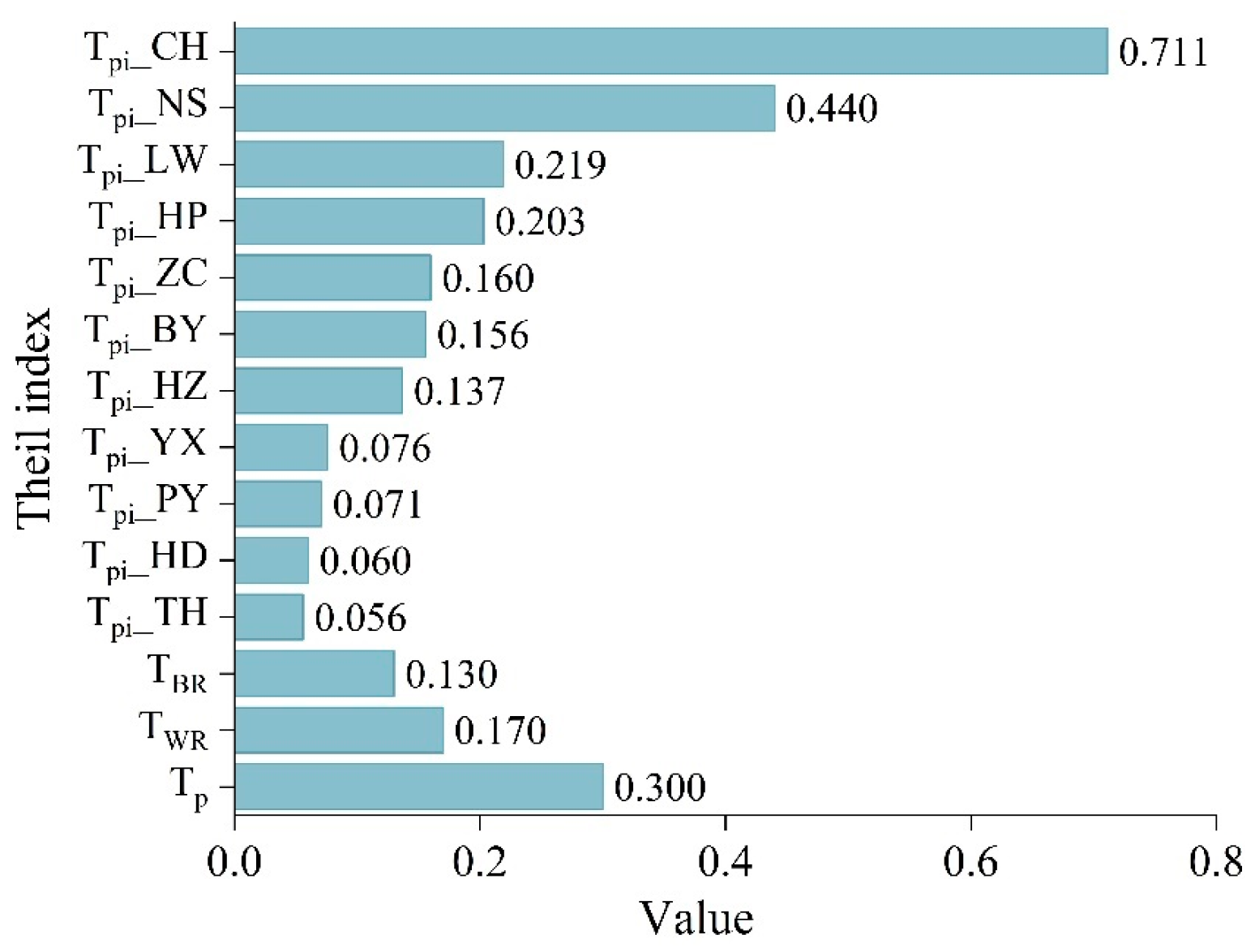
| Theme | Sources | Resolution | Application |
|---|---|---|---|
| Waterlogging | Guangzhou Water Authority (https://swj.gz.gov.cn/index.html) Toutiao (https://www.toutiao.com/) | point | Waterlogging risk mapping |
| DEM | Resource and Environmental Science Data Platform (https://www.resdc.cn/) (accessed on 6 April 2024) | 30 m | DEM, SLOPE mapping |
| Waterway | OpenStreetMap (https://www.openstreetmap.org/) (accessed on 6 April 2024) | Polygon | DW calculating |
| Road | OpenStreetMap (https://www.openstreetmap.org/) | Polyline | RD calculating |
| Soil type | Resource and Environmental Science Data Platform (https://www.resdc.cn/) | 30 m | SWR calculating |
| Fractional vegetation cover | Landsat 8 Operational Land Imager_Thermal Infrared Sensor | 30 m | FVC mapping |
| Impervious surface fraction | Zhang et al. [45] | 30 m | ISF mapping |
Disclaimer/Publisher’s Note: The statements, opinions and data contained in all publications are solely those of the individual author(s) and contributor(s) and not of MDPI and/or the editor(s). MDPI and/or the editor(s) disclaim responsibility for any injury to people or property resulting from any ideas, methods, instructions or products referred to in the content. |
© 2024 by the authors. Licensee MDPI, Basel, Switzerland. This article is an open access article distributed under the terms and conditions of the Creative Commons Attribution (CC BY) license (https://creativecommons.org/licenses/by/4.0/).
Share and Cite
Zou, B.; Nie, Y.; Liu, R.; Wang, M.; Li, J.; Fan, C.; Zhou, X. Assessing the Impact of Urban Morphologies on Waterlogging Risk Using a Spatial Weight Naive Bayes Model and Local Climate Zones Classification. Water 2024, 16, 2464. https://doi.org/10.3390/w16172464
Zou B, Nie Y, Liu R, Wang M, Li J, Fan C, Zhou X. Assessing the Impact of Urban Morphologies on Waterlogging Risk Using a Spatial Weight Naive Bayes Model and Local Climate Zones Classification. Water. 2024; 16(17):2464. https://doi.org/10.3390/w16172464
Chicago/Turabian StyleZou, Binwei, Yuanyue Nie, Rude Liu, Mo Wang, Jianjun Li, Chengliang Fan, and Xiaoqing Zhou. 2024. "Assessing the Impact of Urban Morphologies on Waterlogging Risk Using a Spatial Weight Naive Bayes Model and Local Climate Zones Classification" Water 16, no. 17: 2464. https://doi.org/10.3390/w16172464
APA StyleZou, B., Nie, Y., Liu, R., Wang, M., Li, J., Fan, C., & Zhou, X. (2024). Assessing the Impact of Urban Morphologies on Waterlogging Risk Using a Spatial Weight Naive Bayes Model and Local Climate Zones Classification. Water, 16(17), 2464. https://doi.org/10.3390/w16172464








